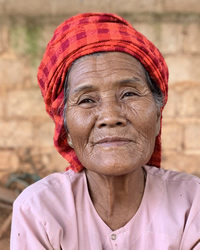Sino-Burmese in China, Macau

Photo Source:
Anonymous
|
Send Joshua Project a map of this people group.
|
| People Name: | Sino-Burmese |
| Country: | China, Macau |
| 10/40 Window: | Yes |
| Population: | 21,000 |
| World Population: | 30,754,900 |
| Primary Language: | Burmese |
| Primary Religion: | Buddhism |
| Christian Adherents: | 1.00 % |
| Evangelicals: | 0.30 % |
| Scripture: | Complete Bible |
| Ministry Resources: | Yes |
| Jesus Film: | Yes |
| Audio Recordings: | Yes |
| People Cluster: | Burmese |
| Affinity Bloc: | Tibetan-Himalayan Peoples |
| Progress Level: |
|
Introduction / History
Burmese civilization goes back 3500 years in the Irawaddy Valley where people were using bronze tools, growing rice and raising livestock. By the 500s, they had adopted Buddhism, which was a turning point for their culture. In the 1000s, the Bama people arrived from the hills of Tibet, and King Anawrahta unified Burma as a nation in 1057. Other kings followed who established Buddhist pagodas, monasteries, libraries, and even places of higher learning. They could control their water supply in such a way that they increased their rice harvests. This civilization waned in the 1300s partly because they gave too much of their resources to the Buddhist monks. This left them more vulnerable to the ravishes of the Mongol Empire and the Tatars. It took another 200 years before a new, expansionist Burmese leader arose, Bayinnaung. He unified Burma for a short time through conquest, but after his death, sections of his empire broke away. The Burmese expanded in the early 1800s, but the Chinese stopped them and by the British Empire, which made Burma a province of India for a season.
For many years, there have been ethnic Chinese in Myanmar, many of whom intermarried with the Burmese majority. We also call them the Sino-Burmese. In 1962, there were anti-Chinese riots in Burma (now called Myanmar). They are re-establishing their culture in the former Portuguese colony of Macau, which is now part of the PRC.
What Are Their Lives Like?
The Sino-Burmese in Macau are devout Buddhists who are trying to maintain their religious culture by having the annual Water Festival. This Buddhist-based festival gives the Sino-Burmese in Macau a chance to experience nostalgia for their customs that date back to when they lived in Burma. It reinforces their culture, and the Macau government encourages it as a tourist attraction.
What Are Their Beliefs?
The Burmese are predominantly Hinayana Buddhists. The traditional goal in Buddhism is to seek the middle path to Nirvana, or ultimate peace. They believe that death is not a threat to one who has done good deeds. Instead, it is simply a "passing" from one life to another. They believe that those with less merit are reborn as demons, ghosts, animals, or inhabitants of hell.
Though the Burmese are predominantly Buddhist, they have mingled many animistic practices (based on the belief that non-human objects have spirits) with Buddhism. Their animistic beliefs center on inherently evil spirits called nats. Sadly, they spend their lives trying to appease the nats, hoping for protection from other evil spirits. All of their homes have altars for the spirits, as well as a statue of Buddha.
What Are Their Needs?
The Burmese left their homeland in search of peace. They need loving Christ followers who will introduce them to the Prince of Peace. Fervent prayer and increased evangelism efforts are the keys to seeing them reached with the gospel.
Prayer Points
Pray that the sheer wonder of knowing Jesus and the impact he has on lives will draw Burmese people in Macau to the Throne of Grace.
Pray the hearts of the Burmese people would be stirred by a sovereign work of the Holy Spirit readying them for the gospel message.
Pray they will experience dreams and visions of Jesus leading them into a saving relationship with him.
Pray for an unstoppable movement to Christ among the Burmese people in Macau.